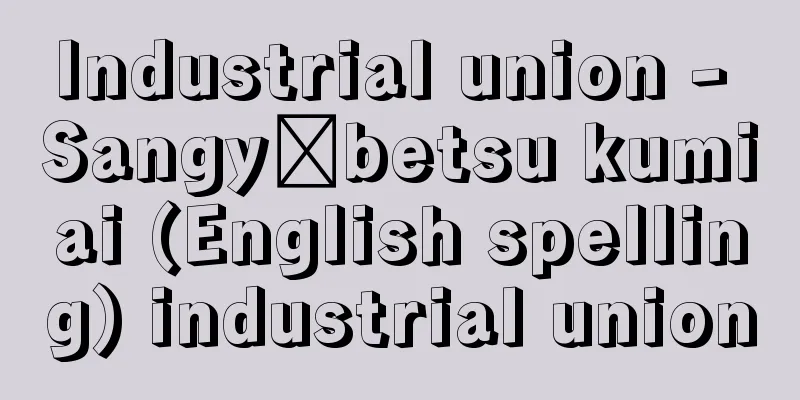Industrial union - Sangyōbetsu kumiai (English spelling) industrial union

|
The trade unions are organized by occupation, and are made up of skilled workers in a particular occupation or trade. Industrial unions were established and developed in response to the monopoly stage of capitalism. In other words, with the development of mass production methods centered on the mechanization of production processes, old-style occupations and skilled workers were dismantled, and a large number of semi-skilled and unskilled workers were introduced into the production process. On the other hand, occupational unions that were separated within large companies were weakened, and an organizational form called industrial unions, which are based on the commonality of working conditions and working environments in the same industry and organize into one union regardless of occupation or skill level, became necessary and effective. In the UK, the National Railway Workers' Union, founded in 1913, was the earliest. In the US, from the 1920s to the 1930s, a movement to reorganize part of the American Federation of Labor (AFL), which was based on occupational unionism, grew to organize a wide range of unskilled workers, and in 1938, the Congress of Industrial Organizations (CIO) was formed, resisting the oppression of employers (the two organizations merged to become the AFL-CIO in 1955). Industrial unions occupy a dominant position today as union organizations in the monopoly stage of capitalism. With some exceptions, industrial unions in Japan are not single unions with individual membership, but are industrial federations or consultation bodies of enterprise unions. These industrial unions in Japan are called unit industrial unions (tonsan). [Seiichiro Hayakawa] [Reference items] | | | | |Source: Shogakukan Encyclopedia Nipponica About Encyclopedia Nipponica Information | Legend |
|
職種や熟練度の違いにかかわりなく、同一産業に従事する全労働者を一つの労働組合に組織するものであり、一産業一組合がモデルとなる組織である。それに対して、職業別労働組合(クラフト・ユニオン)は、特定の職業や職種の熟練労働者を中心に組織される。 産業別組合は資本主義の独占段階に対応して成立・発展した。すなわち、生産過程の機械化を中心とする大量生産方式の発展に伴い、旧型職種や熟練の解体が進行し、大量の半熟練・不熟練労働者が生産過程に導入された。一方で巨大企業内で分立する職業別組合は弱体化し、ここに、同一産業における労働条件や作業環境の共通性を基礎とし、職種や熟練度の違いを越えて一つの組合に組織する産業別組合という組織形態が必要かつ有効なものとなった。イギリスでは1913年設立の全国鉄道労働組合がもっとも早かった。アメリカでは1920年代から1930年代にかけて、職業別組合主義にたつアメリカ労働総同盟(AFL)の一部を改組し、広範な不熟練労働者の組織化を図る運動が高まり、使用者側の弾圧に抗しつつ、1938年に産業別組合会議(CIO)が結成された(1955年に合同してAFL-CIOとなる)。産業別組合は資本主義の独占段階の組合組織として今日支配的地位を占めている。なお、日本の産業別組合は、一部の例外を除き個人加盟の単一組合ではなく、企業別組合の産業別連合体または協議体である。こうした日本の産業別組合は、単位産業別組合(単産)とよばれている。 [早川征一郎] [参照項目] | | | | |出典 小学館 日本大百科全書(ニッポニカ)日本大百科全書(ニッポニカ)について 情報 | 凡例 |
<<: Industrial unified struggle
>>: Industrial Classification - Sangyōbunrui
Recommend
Ohigan - Ohigan
…The spring and autumn equinoxes are the two days...
Brick cheese
…It is aged for 3 to 6 months and has a mild sour...
Trichotillomania - Trichotillomania
This condition is common among girls in their teen...
Oei-ki
A war chronicle that records the course of the Oe...
Asahidake [Hot Spring] - Asahidake
...Sekko spring, 47-51°C. It springs from a plate...
Sacrifice - nail (English spelling)
Offerings and sacrifices to the spirits. There is...
Iquique (English spelling)
A port city in northern Chile facing the Pacific O...
Basic characters - Kisomoji
…Shorthand systems, which are used as a means of ...
Aksakov, IS (English spelling) AksakovIS
...Son of ST Aksakov. His elder brother, Konstant...
Bohol [island] - Bohol
An island in the southern part of the Visayan Isla...
NPT - NPT
Nuclear Non-Proliferation Treaty Source: About Sho...
Szasz, T. (English spelling)
...An ideological trend in psychiatry that emerge...
Miserabilism (English spelling)
…Born in Paris. Having experienced the horrors of...
Coastal Trade (Japan-Soviet) - Enganboueki
... The Soviet Far East and Eastern Siberia are c...
Leptomitus lacteus (English name) Leptomitus lacteus
…[Tsubaki Keisuke]. . . *Some of the terminology ...
![Joboji [town] - Joboji](/upload/images/67cbe0408e5a4.webp)
![Matama [town] - Matama](/upload/images/67cce60aaad29.webp)







